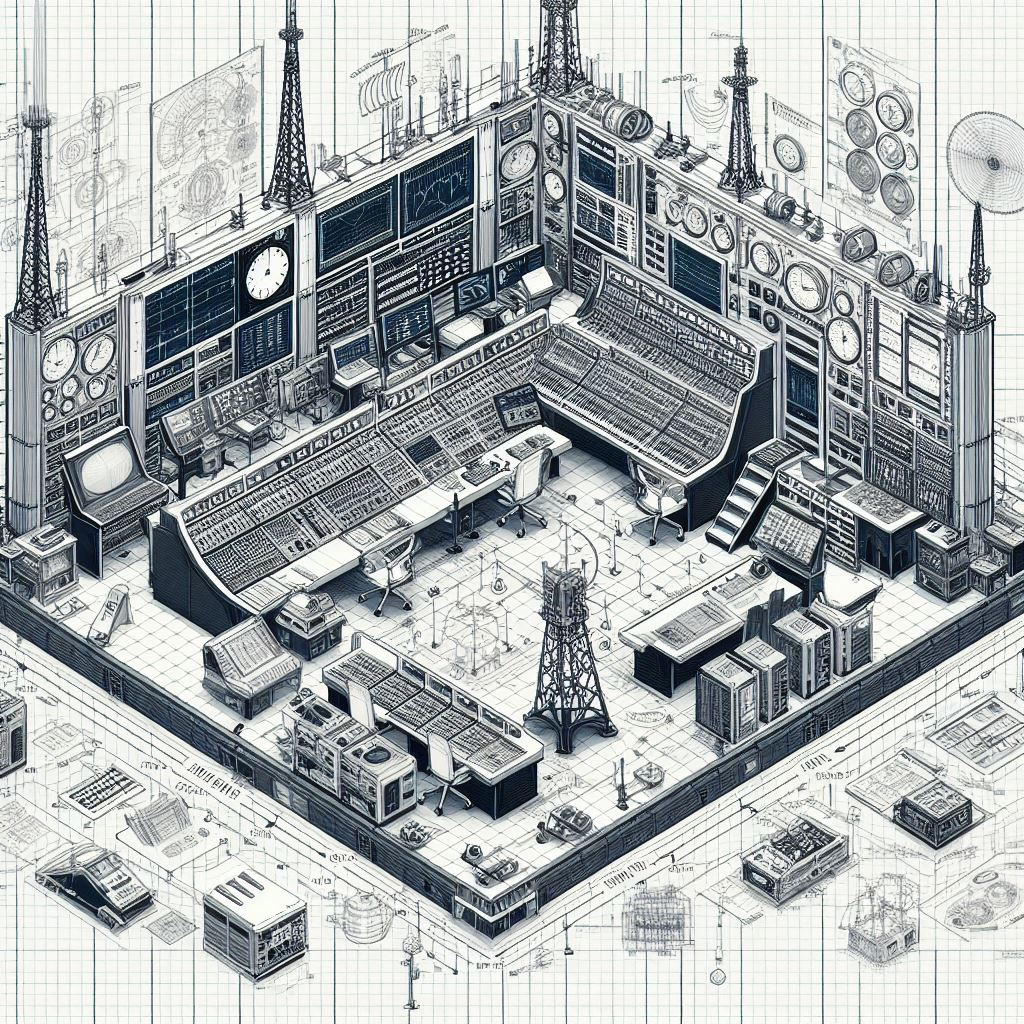
OK, here comes the hard part.
In yesterday’s post, “A Blueprint For Radio” (and you should probably read it first here), Paul Jacobs took on some of the big boulders that have been in radio’s way for some time now. His recommendation? Take it down to the studs and build it back better (to not coin a phrase).
Paul proposed a 4-point plan, starting with an industry SWOT for radio, assessing the medium and where it stands in the harsh L.E.D. lights of 2024. All well and good. But now, it’s action time. So often over the years, Paul and I have heard the charge loud and clear:
“Fix it…but don’t change anything.”
In so many words, of course. Suffice it to say, nothing’s going to get fixed without breaking some china and making some messes. Sacrifice – the necessary but not the needless kind – has to be met head on. Paul has carved out a list of action steps that will hopefully provide a way forward. Think of part two as “the fine print,” the tough work that has to be done.
His post yesterday was a great conversation starter. But now, it’s game time. – FJ
So now, we’ve got a plan in place, everyone’s on the same page (pretty much), we have a mission and a statement of purpose. Let’s get down to the brass tacks, put the pedal to the metal, and every other cliché you can think of, and let’s get to work:
Speak in one voice – In a run for political office, the candidate is out front, making speeches and hitting the key points to support her rationale for why they’re the right person for the job. But concurrently, their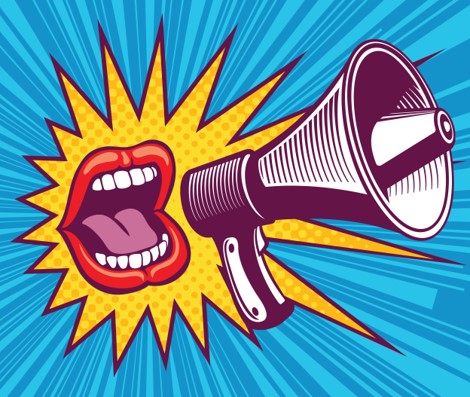 surrogates are also giving speeches, writing articles, and appearing on mass media outlets, sharing the exact same points. Nobody deviates from the message.
surrogates are also giving speeches, writing articles, and appearing on mass media outlets, sharing the exact same points. Nobody deviates from the message.
From CEOs to salespeople to talent to receptionists, from Los Angeles to Lincoln, the radio industry must adopt the same strategy. What’s the rationale to listen to radio or to include it in a marketing plan? What are radio’s inherent strengths in this competitive ecosystem? What differentiates radio from all of the other media options advertisers and audiences can choose from? What does radio provide beyond :60s and :30s, music and talk?
The only way to turn around the radio industry’s “approval ratings” – PUMM and revenue – is for everyone to sing from the same hymnals, join in on the campaign, amplify and reinforce the message, and to speak in one voice.
For too long, it’s been every man and woman for his and herself. That might have served the industry well during its formative decades, but when you’re under attack, you’d better form a coalition of the willing, radio’s version of NATO, where we’re all in this together.
Whether you’re on the bus for the “AM For Every Car Act” or not, you have to admit it was proof of this concept. For one rare, shining moment, industry leaders of all stripes came together for a common purpose.
Guess what? It can work again. Rinse, repeat.
Promote the value of the audience – I scream every time I read an article touting radio’s reach. Yes, radio’s ability to attract tune-in from a huge number of citizens is really impressive, but it’s like a sugar high. It’s a number with no teeth. Advertisers are constantly reading about radio’s decline, they hear from their kids that radio is irrelevant or nonexistent, and they are being fed the same warmed over “has-been” talk by radio’s digital competitors. These stories have much more impact than a metric, and 92% is merely a number (and one that I bet advertisers either don’t believe, don’t care about, or both).
Radio’s value is in its ability to move audience: their responsiveness to broadcast messages, and radio’s ability to connect them with advertisers. Live testimonials (they’re really bedtime stories), cross-platform campaigns, live in-person events, and more enable radio stations to do so much more than digital – and yes, other traditional – media competitors. But if all we’re going to do is focus on the size of the audience (which is slowly declining), we are burying the lead.
Size does matter. Until it doesn’t. Radio has better stories than its tired reach claims. It’s time to message them better and with more consistency.
We’re free and easy! It’s so obvious, we just don’t talk about it. But the fact your P1 radio station (not to mention your P2, P3, and P4) don’t sent you an invoice at the end of the month a la Netflix, Spotify, Sling, and Xfinity is something that the aforementioned 92% of America values. But let’s not let that get in the way of our “7 Song Supersets” or our umpteenth text-to-win cash content.
These two benefits sit at the top of the “Why Radio?” heap year in and year out in our Techsurveys. Sorry, morning shows, music directors, and talk show hosts, but don’t you think the audience is trying to tell us something?
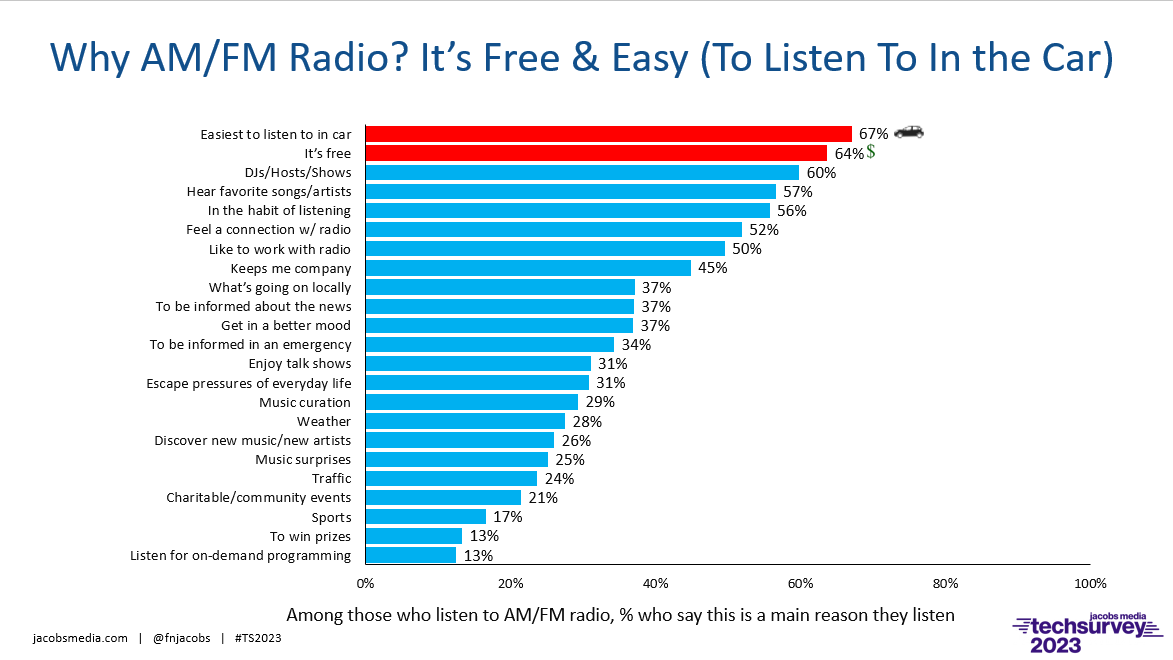
For radio, this is our steel sword, our nuclear weapon – as the cost of media content rises, fragments, and becomes even more difficult to access, radio is free, ubiquitous, and easy to access. Believe me, it provides an enormous advantage over its competitors to a point where they hope we don’t figure it out. And to date, we haven’t. (BTW, I took a peek and the soon-to-be-released Techsurvey 2024, and both are still topping the chart.)
And most advertisers will tell you “free” is the most powerful word they can use in ads – we’d be speaking their language. Audiences respond to it, too.
Radio needs a 50-state strategy. In order to positively change the medium’s image, it’s going to require all hands on deck. Having CEO’s visit agencies or giving speeches is nice, but it barely scratches the surface.
Changing radio’s deep-rooted perceptions needs to be treated like a full-scale national political campaign, with everyone who works in the industry – from the corporate teem to the stars in the studios – repeating the talking points with energy and enthusiasm to anyone and everyone who will listen.
In its early days, public radio figured this out…sort of. They produced laminated cards comprised of their core values. Whether you joined at the station or NPR level, you received one. Public radio employees carried these values with them so they could share at every opportunity. And guess what? When we look at the “Why Radio?” chart in our 15 Public Radio Techsurvey year in and year out, they’re all hovering at the top of that chart. This isn’t happening by accident.
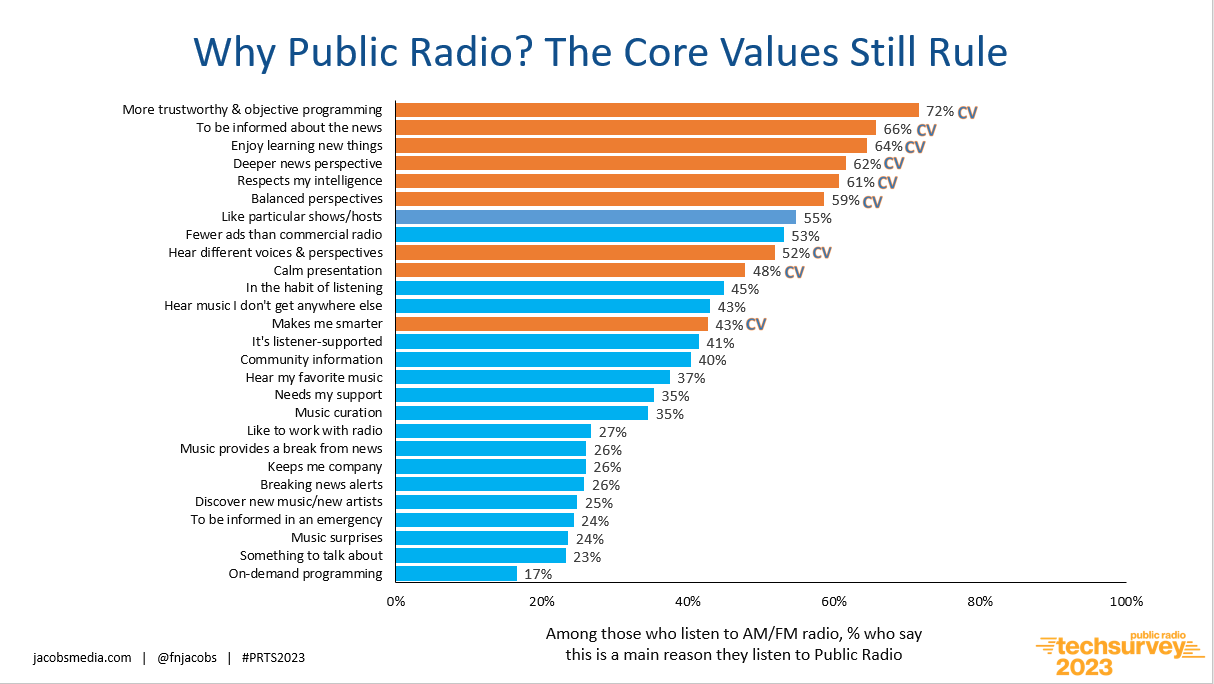
It works because every employee knows what public radio stands for. And their programming almost always exudes them. Talking the talk. Walking the walk.
Broadcast radio needs to adopt the same approach today. The strategic plan will produce a core message, and of course, the foot soldiers at every station across the U.S. will have to carry it through. Just like politicians have boots on the ground, knocking on doors, and spreading the word, radio needs to adopt that same sweeping strategy. Every radio salesperson needs to be armed with the same laminated cards (and smartphone video), sharing the consistent message with advertisers.
In each state there is an organization perfectly suited to coordinate and organize these efforts – your state broadcaster associations were built for this task. They can be the ground zero of this campaign, coordinating events for advertisers, distributing information, and reinforcing a collaborative focus. They can help provide training for salespeople, so the quality of representation is high and consistent.
They almost all run awards programs for stations in their states and regions. Why not organize the next competition around who can produce the best assets for radio’s new set of core values? The high schools, colleges, and radio stations that vie for these awards all have incredible talent. Something tells me these legions of audio and video producers could create some wonderful campaign assets for radio.
An example of how one state broadcaster association is meeting the moment is right here in Michigan. As part of their strategic plan (full disclosure: we helped them develop it), the Michigan Association of Broadcasters and their member stations recognized they had a fundamental problem – attracting young people to make radio broadcasting a career choice. Under the guidance of CEO Sam Klemet, the MAB produced an impressive multimedia campaign. “Be There,” featuring ads on radio and television stations, at events, online, and in other places.
Broadcasters and their member stations recognized they had a fundamental problem – attracting young people to make radio broadcasting a career choice. Under the guidance of CEO Sam Klemet, the MAB produced an impressive multimedia campaign. “Be There,” featuring ads on radio and television stations, at events, online, and in other places.
While it’s too early to measure the campaign’s impact, it’s an example of how one organization identified a problem, addressed it, created a solution, and marshaled the forces of the collective power of their members. You can check it out here.
Radio needs to clean up its commercial mess. Too many radio stations run too many commercials. OK, let me rephrase that: too many radio stations run too many terrible commercials.
It’s not a dirty little secret. Everyone knows.
And to just sweep it under a rug and declare, “Well, there’s nothing we can do about it,” so let’s work on something we can control is irresponsible.
But we can do something about it. Over-commercialization hasn’t helped appreciably grown revenue. It’s hurt it. Too much inventory drives pricing down. Too many commercials drive listening down.
Deal with it, and fix it.
And then there’s the quality of ads we hear. As stations have reduced head count, production directors have been forced to become commercial factories, cranking out spots for multiple stations on the fly. The time allocated for creative thinking and writing have been replaced by ads that sound the same, aren’t compelling, and as a result, aren’t as effective as they should be.
Thank goodness for AI – now we can crank out mindless annoying ads seamlessly and easily.
Visionaries like Jerry Lee and the late Bob McCurdy have been lone voices in the radio wilderness – for decades – advocating for a better advertising environment and better, more compelling commercials. Jerry’s done the research, too, and would be happy to share it with the industry, SBAs, and anyone willing to rethink the efficacy of running 20 commercials an hour and expecting a turnaround in listening or billing.
It’s time to advertise…radio. It’s the age-old impossible question: How can we promote the need to advertise to companies, brands, and retailers if we don’t practice what we preach as an industry? Gone are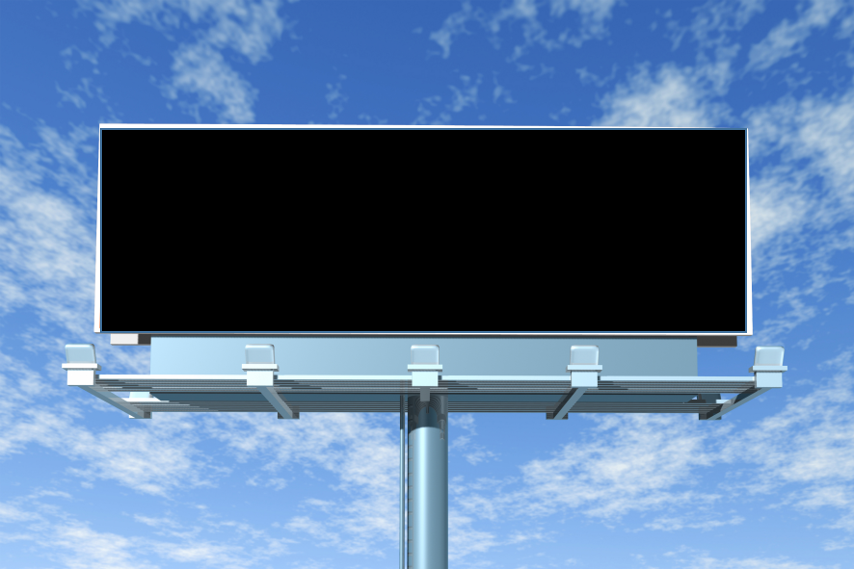 the days when individual stations have the budget to market, and don’t think that’s been missed by advertisers. Compared to several years ago, the radio industry is all but invisible.
the days when individual stations have the budget to market, and don’t think that’s been missed by advertisers. Compared to several years ago, the radio industry is all but invisible.
It doesn’t have to be this way. As part of the blueprint to address radio’s image deficits, what would happen if every station in a market purchased a single billboard promoting radio in a coordinated campaign? In some markets, there would 30-40 billboards spreading the word about why radio is viable and important.
Like those campaigns where a city’s symbol – Chicago/Mrs. O’Leary’s cow – is creatively displayed all over town by local business, organizations, and supporters, a coordinated effort to deliver the radio message isn’t a pipe dream – it’s doable.
And of course, parallel campaigns – same message – using each stations’ own air, email databases, websites, social media, and other assets would amplify the campaign.
Use personalities, storytelling, and the power of “local” to impact the community. Can you name a personality on Spotify (no, DJ X doesn’t count)? Who is the “face” of Facebook (outside of the beleaguered, unpopular Zuck)? Radio has the “secret sauce” with which to deliver an important message – its talent. Its storytellers. In every market, there are still radio personalities with local caché and market cred. People want to meet them, hang out with them, and in a lot of cases, trust them.
beleaguered, unpopular Zuck)? Radio has the “secret sauce” with which to deliver an important message – its talent. Its storytellers. In every market, there are still radio personalities with local caché and market cred. People want to meet them, hang out with them, and in a lot of cases, trust them.
Radio is also not an algorithm, a (non)creative concept generating negative momentum among consumers, many of whom crave a human connection in these lonely times. Whether it’s curating a playlist on the first day of spring, talking about and giving voice to listeners during a civic crisis, or simply keeping a driver company on the way to or home from work, this is what radio does better than any other medium – bar none. Rather than a dumbed down collection of songs programmed by a bot, humans behind the mic have the capacity to deliver surprise and delight – if we give them the freedom and opportunity to do so.
We often say that “Radio needs to do a better job telling its story.” So, why not turn over the controls to the best storytellers in the business? Fred and I work with the Children’s Miracle Network Hospitals, the organization that works with radio stations throughout the U.S. (and Canada), putting on incredibly successful “Radiothons” and fundraisers, year in and year out. And in the research we conduct with and for them, a common refrain from the audience, sponsors, and hospitals is just how effective radio personalities are at connecting these communities, telling poignant stories, and raising hundreds of millions of dollars every year, whether there are recessions, pandemics, or other excuses.
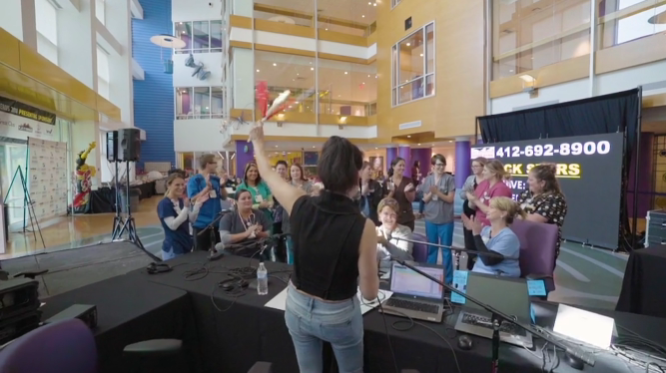
One of CMN Hospitals best performers is legendary WDVE in Pittsburgh, raising millions for the University of Pittsburgh Medical Center’s Children’s Hospital. If you ask programmer John Moschitta, hospital director of corporate partnership Joey Warren, and CMN media director, Mitch Baker, why the station is consistently so successful, they’ll tell you it’s the personalities – their energy, passion, commitment, and ability to draw the Pittsburgh community in their cause.
How effective are radio’s personalities at getting to the heart of the matter? I was on Facebook last night and ran into this heartfelt, personal post from radio veteran, Bob Stroud, long-time personality extraordinaire at Hubbard’s WDRV in Chicago:

I’m sorry. This didn’t happen on Spotify or YouTube. And ChatGPT couldn’t write it, and an AI bot couldn’t deliver it.
Years ago, when radio routinely made national sales trips, we would occasionally bring a member of the air staff . . . . and those always turned about to be the best visits. They were also the easiest for me, because I just had to sit back and watch the magic happen. Advertisers love meeting the personalities, and in especially in cases where they are well-prepped, they deliver.
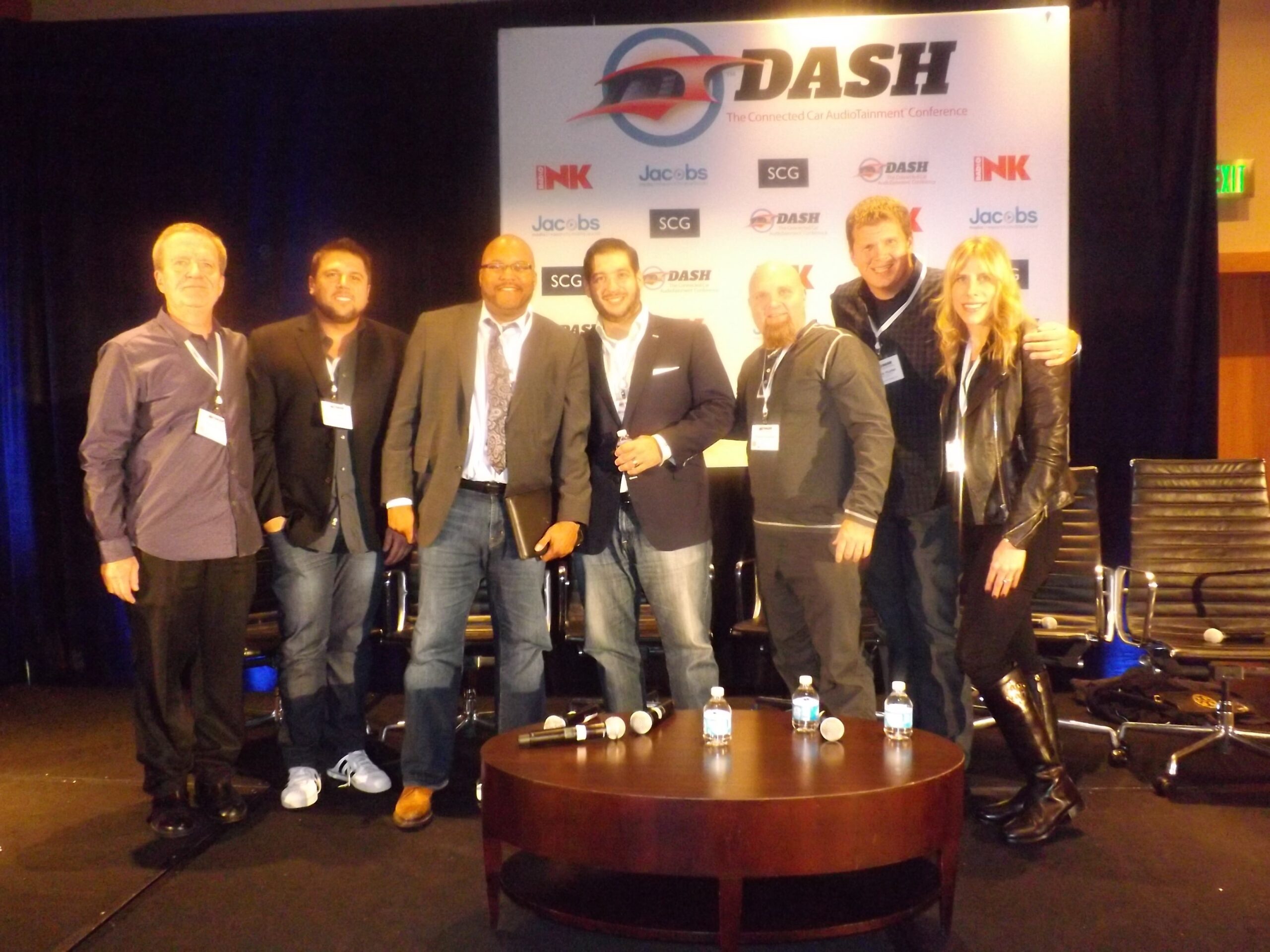
Our best DASH Conference sessions? When we recruited Detroit radio’s best personalities to take the stage. Every jaded auto exec at our event put their phones down to watch the fun. Dave & Chuck the Freak, Jay Towers, Valenti & Foster, Mason, Jeff Gilbert – they were all there to remind our automotive guests about the power and passion of local radio
For our radio campaign, we need to get them out of the studio and in front of clients. Nobody can tell the story of the station and the medium better than they can (with apologies to all of the salespeople out there.)
But “Live and local” needs to be much more than a well-worn slogan. Radio is live and no other medium can have the impact and the ability to connect with communities in the moment – physical regions and like-minded people – like station talent.
They reflect what’s happening in their cities and town, the agony and ecstasy with their sports teams, and doing their version of play-by-play about events and happenings that are near and dear to audience and advertisers. With the decline of local newspapers and hometown TV stations, who else will pick up the slack?
And then there are local events. Radio historically has done an admirable job working the streets and emceeing shows, festivals, parties, and local gatherings. But over time, they’ve come with a talent fee or a media buy required. That’s not going to cut it in an environment where radio has to roll up its sleeves and collectively support the industry. We need to amp up radio’s visibility and treat these as opportunities to “campaign” to get people to “vote” for radio. This needs to be a coordinated effort that transcends just a station’s or a cluster’s needs. Again, that might appear to be altruistic, but desperate times require desperate measures.
Radio needs to appeal to younger generations – This is not news. You know it, I know it, Fred’s been writing about since the inception of this blog. And here we are, all these years later, and broadcast radio still has no youth strategy. That’s like Walmart not having a new customer strategy. Neither makes sense.
Radio listening is precariously aging every year, and because of a myopic focus on 25-54s, teens and young adults have been ignored. As Fred wrote last week, in “Radio’s Teenage Wasteland,” every other respectable media platform is prioritizing Gen Z (and soon, Gen Alpha) – except for us.
Ask yourself, why would a young adult listen to the radio if we aren’t taking them seriously, researching them, and creating content – whether on the radio or not – that appeals to them?
It’s time to get serious as an industry about this issue. The best time to do this was yesterday.
Give the audience a seat at the table – Successful companies and platforms in 2024 have something in common – they listen to their customers. Radio needs to follow suit. Virtually every one of these steps works more effectively when the audience is consulted first.
All the insights I’ve offered these last two days have emanated from this practice Fred and I have worked to perfect: listening to consumers.
In 2024, radio finds itself in a vicious cycle and we can’t piecemeal a solution or stick a band-aid on it. We’ve got to break the cycle and lean into the problem. As an industry, radio still has myriad strengths, but they are being overwhelmed by bad imaging, bad press, competitive options, lousy execution, and scant attention on creating great experiences. and no messaging strategy. So it shouldn’t be surprising that the industry is struggling.
There are a lot of smart people in the business who might have other thoughts, but if I was the CEO of Radio, this is my blueprint. My hope is that this is the start of a conversation that actually leads to action, because it’s clear that while doing nothing is an option, it’s clearly the least best (and frankly, dumbest) option we can take.
In some ways, it’s easier for politicians – all of their efforts are focused on one day . . . election day. They win, or they lose and go home.
Radio isn’t like that. Every day is election day. So radio won’t lose or go home. But it’s safe to say that if we don’t change the way we operate and do business, that’s where we will find ourselves.
- For Radio, Will It Be Christmas In April (And Hopefully, May)? - April 21, 2025
- The Revolution Will Not Be Monetized - December 30, 2024
- What Kind Of Team Do You Want To Be? - October 4, 2024




I agree with you on the ‘touting of radio’s reach.’
‘Reach” is one of those tricky words that can be a noun or a verb.
No matter how high the bars go on the power point presentation…
Reach doesn’t matter unless it results in a touch.
Not only that, the number is like tissue. It doesn’t tell a story, isn’t memorable, and has limited impact. It’s a nice data point, but I think we can agree it isn’t solving the greater problem.
Ooh…EXCELLENT last sentence!!! I remember when I first heard of reach and found out what it meant. It just happened to be with regard to a television station. I wondered who, exactly, cared about reach unless those televisions were actually tuned in. If I can see through smoke and mirrors, so can most other people. Again, great last line. I’ll be using it;)
Free consulting!
Seriously, glad you enjoyed the post. Hopefully this will stir the pot a bit and get some smart conversations started. Sitting around and watching this is painful, but collectively, we can make things better.
Sarcasm and reference to the station I grew up listening to? Paul get out of my head, you stole my ideas. Haha, but for real, if a blind 35 year old with minor success in the industry can come to the same conclusion, then it is worse than being myopic, it’s a willingly blindfolded industry playing pin the tail on the jackass.
Brandon, this isn’t brain surgery. We all know what the problems are (and there are more I didn’t mention). The question is, does the radio industry have the will to come together to confront them?
Coming together is the key. We have to stop competing against each other and address the REAL competition out there. If you need some folks down here in the Music City to help get this message across, let me know. I am in and I know a few more who will be.
John, I hope this could be a start of a movement, a new way of how our industry operates. Keep stoking the fires and let’s see what happens!
Hope you are doing well.
Now you’ve gone and done it, Paul—removed every excuse for failure. And sown the seeds of hope for our beloved industry. Thank you.
My work here is done!
Thanks for a thoughtful article . However rural radio stations are closing right and left especially around me. I have the last rural in a region. The older ones died, with the AMs going first. Unless you have 100 KW, a rim shot doesn’t have a chance in hell to survive.
Lucky and blessed the metros with the “too many commercials” problem you describe. They don’t have a problem and probably never will. The NAB and the big corporations fight third adjacent channel relaxation and the FCC obeys their command along with the bought and sold crooks in Congress who had the bill die .
Please talk about the death of the AMs and the rural FMs. We the rurals need the help now to survive.
Thanks for bringing up this issue, Xavier. We have been involved in the Save AM/Car act, but the issues you bring up run much deeper than that – the financial survival of radio in rural areas. When I’m speaking with small market broadcasters, the sense I get is their business is better than in the larger markets, but I don’t think there’s been any focus on rural. We will continue to watch this and comment on it as things progress.
Keep fighting the good fight. Rural areas need broadcasters.
Paul,
Great information and you are spot on!
I Wrote and article in the past titled, “What If”… What if Radio could have a do over, what could/should they do differently? The two main things are, 1) Promote themselves better, and 2) Train the media reps better.
I sent a note to RAB several years back suggesting that that re-create a national campaign semiliar to the 1965 Stan Freberg campaign, “Who Listens to radio”, You can youtube the campiagn here… https://www.youtube.com/watch?v=USotnlORBZ0
I heard crickets – not even a note back saying they received my email.
The problem with this is, many stations/groups will not air it as these are 60-sec ads. Hey, if someone can create it better in a 30, go for it, but I would bet against it.
Hire Wizard Academy or Orkin’s Radio Ranch to create and produce. Or, run a nation wide contest amoung all creatives, agencies, local stations, anyone and everyone and offer $100,000 (?) prize for winning campaign, 6 to 12 ads minimum.
Radio, we are great at promoting other businesses, including those that compete with us, (Youtube, Amazon, Facebook, Twitter/X, Instagram, Podcasting, etc) but we SUCK at promting ourselves. Geez!!!!!!!! It seems like a no brainer…
This is RAB’s job and they should be leading this charge and challenge, not Paul and Fred Jacobs!
Love what you do! If you need any help, I’m all in!
Thanks, Rick. Acting in the way you describe and I write about aren’t natural acts in our business. We can only hope leaders can take a step back from the day-to-day and see the bigger picture – radio is at an inflection point.
Hopefully efforts like ours will poke the bear and maybe they will see there are opportunities to turn things around and grow. Will radio return to its glory years? No. But there’s no reason why we can’t become more vital in the media lives of our listeners (and more of them)
So, other than you and I and a few others writing on this topic, how do we get it into the ears of the powers that be?
The Preceptions of listeners, business ownes, agencies need to be changed. Until they are, preception remains reality.
I beleive that you and Fred have the hand that can yank the ear of the idustry. I will help in anyway I can. Let’s start yacking their ears! It’s not to late!
First, acknowledging the problem is light years ahead of where most radio honchos are. Thanks Paul for two days of really important and thought provoking columns. As for the rest:
I’ve long been a critic of radio speaking with one voice. First, a lot of radio’s voices are well, misguided and choosing the wrong one to unite behind could make things worse. The issue isn’t that radio is telling its story badly, its that radio’s story is bad. “In order to positively change the medium’s image…” -change the medium. Radio’s problems don’t start with poor promotion, they start with a worse version of a 35 year old product, with even less focus on under 40s than back then. Yes, radio needs to realize that it’s approach to ads (number and quality) requires serious reassessment.
But at the end, isn’t this all about radio creating a product that more people, (particularly younger ones) want to listen to more? A better product with more listeners would go a long way toward solving this list. Any solution that revolves around dressing up radio’s current product is likely to fail IMO.
The only thing that’s on-point in this post is every single bit of it, Paul, and it absolutely starts with radio coming together to compete against non-radio rather than radio operators still trying to compete and sell against other radio operators.
Bravo!
Thanks, Steve. What’s that about a blind squirrel catching a nut? Every once in a while . . .
But seriously, even if we can’t all agree on solutions, the first step is recognizing there’s a problem, and the current way the industry is dealing with it – or NOT dealing with it – isn’t working.
So why not try something new?
Back in the day Todd Storz sat in a restaurant and heard people play the same songs over’n over. Fast forward to Bill Drake and his “more music” format. Buzz Bennett and t he “Q” format. Fred (and Paul) Jacobs and Classic Rock. Radio’s done a great job at seeing something work-and emulating it. When radio finally agrees with what’s here (and it ‘s all correct), puts it into practice and sees it work – then the rest of the industry will (we hope) emulate and succeed. Until then -we continue to chase our tails.
Dave, it’s one thing to chase our tails. It’s another to not even realize we’re doing it.
I have done my best observing – yes, especially with Classic Rock – by observing, by listening to listeners talk about what the music, the artists, the memories, the times mean to them. Data confirms behavior, tastes, tendencies, and trends. But observation and just being a good listener is priceless in the process of getting it right. Thanks for the reminders, Dave.
A wish list:
– FM chips in smart phones How about in TV streaming boxes too?
– Change the system currently used for HD radio. My understanding there is huge charge to involved to use it. When TV went to HD that technology was open source. Do the same with radio. Bundle this change up with the drive to save AM radio.
– How about the main frequency is the “local” station. The subs or HD are affiliates of national networks. Wasn’t SMN a successful company (and all of the ways they helped small market stations?) Is that still viable?
– As mentioned in the article, stop sets have to be reduced. People who stream music are gonna be hard pressed to go to radio. Its terrible to listen to and I cant believe that advertisers don’t complain when their spot is next to a competitor.
Some food for thought….
While I have significant doubts about the FM chip, there’s other solid ideas here. That was the goal – to get people to start thinking about different ways we can turn things around.
Hopefully this will amount to something.
Thanks for sharing.
And a lot to think about, Jerry. Thanks for the comment.